�
Texts in Applied Mathematics 2
Editors
J.E. Marsden
L. Sirovich
S.S. Antman
Advisors
G. Iooss
P. Holmes
D. Barkley
M. Dellnitz
P. Newton
Stephen Wiggins
Introduction to
Applied Nonlinear Dynamical
Systems and Chaos
Second Edition
With 250 Figures
�
Stephen Wiggins
School of Mathematics
University of Bristol
Clifton, Bristol BS8 1TW
UK
S.Wiggins@bristol.ac.uk
Series Editors
J.E. Marsden
Control and Dynamical Systems, 107–81
California Institute of Technology
Pasadena, CA 91125
USA
marsden@cds.caltech.edu
L. Sirovich
Division of Applied Mathematics
Brown University
Providence, RI 02912
USA
chico@camelot.mssm.edu
S.S. Antman
Department of Mathematics
and
Institute for Physical Science
and Technology
University of Maryland
College Park, MD 20742-4015
USA
ssa@math.umd.edu
Mathematics Subject Classification (2000): 58Fxx, 34Cxx, 70Kxx
Library of Congress Cataloging-in-Publication Data
Wiggins, Stephen.
Introduction to applied nonlinear dynamical systems and chaos / Stephen Wiggins. — 2nd ed.
p. cm. — (Texts in applied mathematics ; 2)
Includes bibliographical references and index.
ISBN 0-387-00177-8 (alk. paper)
1. Differentiable dynamical systems. 2. Nonlinear theories. 3. Chaotic behavior in
I. Title.
systems.
QA614.8.W544 2003
003′.85—dc21
II. Texts in applied mathematics ; 2.
2002042742
Printed on acid-free paper.
ISBN 0-387-00177-8
© 2003, 1990 Springer-Verlag New York, Inc.
All rights reserved. This work may not be translated or copied in whole or in part without the written
permission of the publisher (Springer-Verlag New York, Inc., 175 Fifth Avenue, New York, NY 10010,
USA), except for brief excerpts in connection with reviews or scholarly analysis. Use in connection with
any form of information storage and retrieval, electronic adaptation, computer software, or by similar or
dissimilar methodology now known or hereafter developed is forbidden.
The use in this publication of trade names, trademarks, service marks, and similar terms, even if they are
not identified as such, is not to be taken as an expression of opinion as to whether or not they are subject
to proprietary rights.
Printed in the United States of America.
9 8 7 6 5 4 3 2 1
SPIN 10901182
www.springer-ny.com
Springer-Verlag New York Berlin Heidelberg
A member of BertelsmannSpringer Science+Business Media GmbH
�
Series Preface
Mathematics is playing an ever more important role in the physical and
biological sciences, provoking a blurring of boundaries between scientific
disciplines and a resurgence of interest in the modern as well as the classical
techniques of applied mathematics. This renewal of interest, both in re-
search and teaching, has led to the establishment of the series Texts in
Applied Mathematics (TAM).
The development of new courses is a natural consequence of a high level
of excitement on the research frontier as newer techniques, such as numeri-
cal and symbolic computer systems, dynamical systems, and chaos, mix
with and reinforce the traditional methods of applied mathematics. Thus,
the purpose of this textbook series is to meet the current and future needs
of these advances and to encourage the teaching of new courses.
TAM will publish textbooks suitable for use in advanced undergraduate
and beginning graduate courses, and will complement the Applied Mathe-
matical Sciences (AMS) series, which will focus on advanced textbooks and
research-level monographs.
Pasadena, California
Providence, Rhode Island
College Park, Maryland
J.E. Marsden
L. Sirovich
S.S. Antman
�
Preface to the Second Edition
This edition contains a significant amount of new material. The main rea-
son for this is that the subject of applied dynamical systems theory has
seen explosive growth and expansion throughout the 1990s. Consequently,
a student needs a much larger toolbox today in order to begin research on
significant problems.
I also try to emphasize a broader and more unified point of view. My
goal is to treat dissipative and conservative dynamics, discrete and con-
tinuous time systems, and local and global behavior, as much as possible,
on the same footing. Many textbooks tend to treat most of these issues
separately (e.g., dissipative, discrete time, local dynamics; global dynamics
of continuous time conservative systems, etc.). However, in research one
generally needs to have an understanding of each of these areas, and their
inter-relations. For example, in studying a conservative continuous time
system, one might study periodic orbits and their stability by passing to a
Poincar´e map (discrete time). The question of how stability may be affected
by dissipative perturbations may naturally arise. Passage to the Poincar´e
map renders the study of periodic orbits a local problem (i.e., they are fixed
points of the Poincar´e map), but their manifestation in the continuous time
problem may have global implications. An ability to put together a “big
picture” from many (seemingly) disparate pieces of information is crucial
for the successful analysis of nonlinear dynamical systems.
This edition has seen a major restructuring with respect to the first
edition in terms of the organization of the chapters into smaller units with
a single, common theme, and the exercises relevant to each chapter now
being given at the end of the respective chapter.
The bulk of the material in this book can be covered in three ten week
terms. This is an ambitious program, and requires relegating some of the
material to background reading (described below). My goal was to have the
necessary background material side-by-side with the material that I would
lecture on. This tends to be more demanding on the student, but with the
right guidance, it also tends to be more rewarding and lead to a deeper
understanding and appreciation of the subject.
The mathematical prerequisites for the course are really not great; ele-
mentary analysis, multivariable calculus, and linear algebra are sufficient.
In reality, this may not be enough on its own. A successful understanding
of applied dynamical systems theory requires the students to have an inte-
�
viii
Preface to the Second Edition
grated knowledge of these prerequisites in the sense that they can fluidly
manipulate and use the ideas between the subjects. This means they must
possess the quality often referred to as “mathematical maturity.” A study
of dynamical systems theory can be a good way to obtain this. In addi-
tion, an ordinary differential equations course from the geometric point of
view (e.g., the material in the books of Arnold [1973] or Hirsch and Smale
[1974]) would be ideal.
Chapters 1-17 form the core of the first term material. It provides stu-
dents with the basic concepts and tools for the study of dynamical systems
theory. I tend to cover chapters 7, 11 and 12 at a brisk pace. The main
point there is the ideas and main results. The details can be grasped over
time, and in other settings. Chapters 13-17 could be viewed as belonging to
the common theme of “dynamical systems with special structure.” Chap-
ter 14 is the most important of these chapters. The relation, and contrasts,
between Hamiltonian and reversible systems is useful to understand, and
is the reason for including chapter 16. I often just assign selected back-
ground reading from chapter 13, but knowledge of the relation between
Lagrangian and Hamiltonian dynamical systems is of growing importance
in applications. Gradient dynamical systems arise in numerous applica-
tions (e.g., in biologically related areas) and knowledge of the nature of
their dynamics, and how it contrasts with, e.g., Hamiltonian dynamics, is
important. Chapter 17 is short, but I have always felt that students should
be aware of these results because there are numerous examples of systems
arising in applications that experience a “transient temporal disturbance.”
Throughout the early chapters I discuss a number of results and theoretical
frameworks for general nonautonomous vector fields (i.e., time-dependent
vector fields whose time dependence is not periodic). This area tradition-
ally has not been a part of dynamical systems from a geometric point of
view, but this situation is changing rapidly, and I believe it will play an
increasingly important role in applications in the near future.
Chapters 18-22 are covered in the second term. The subject is “local
bifurcation theory.” The two key tools for the local analysis of dynami-
cal systems are center manifold theory and normal form theory, covered in
chapters 18 and 19. The chapter on normal form theory is greatly expanded
from the first edition. The main new material is the normal form work of
Elphick, Tirapegui, Brachet, Coullet and Iooss, a discussion of Hamilto-
nian normal form theory (following Churchill, Kummer, and Rod), and
some material on symmetries (whose possible existence, and implications,
should be considered in the course of study of any dynamical system). Pos-
sibly sections 19.1-19.3 could have been omitted in this edition; however
it has been my experience that students understand the later (and more
difficult) material more easily once they have been exposed to this more
pedestrian introduction. In chapters 20 and 21 I tend not to cover in much
detail the material related to the codimension of a bifurcation and versal
deformations. This is a standard language used in discussing the subject
�
Preface to the Second Edition
ix
and it is important that the students have all the details available to them
for background reading and see it in the context of the material I lecture
on. New material on Hamiltonian bifurcations and circle maps is included.
The inclusion of introductory material on Hamiltonian bifurcations is an
example of the effort to have a broader and more unified point of view as
discussed earlier. For example, we first describe the “generic saddle-node
bifurcation at a single zero eigenvalue.” It is then natural to ask about the
saddle-node bifurcation in a Hamiltonian system, which turns out to be
rather different. Chapter 22 mainly serves as a warning that the way in
which bifurcation phenomena are discussed in applications may not agree
with the mathematical reality, and appropriate pointers to the literature
are given.
Chapters 23-33 are covered in the third term. The subject is “global
dynamics, bifurcations, and chaos.” There is a sprinkling of new material
throughout these chapters (e.g., a proof of a simple version of the lambda
lemma and a proof of the shadowing lemma), but the structure is basically
the same as the first edition.
There is not a great deal of overlap between the material in the individ-
ual terms, and with the appropriate prerequisites, each of these one term
courses could be viewed as an independent course in itself. The textbook
provides the necessary background for the students to make this a possi-
bility.
Some material has been left out of this edition; in particular, material
on averaging, the subharmonic Melnikov function, and lobe dynamics. The
reason is that over time I have begun to cover averaging and the subhar-
monic Melnikov function as topics in a course solely devoted to perturbation
methods. I cover lobe dynamics in a course devoted to transport phenom-
ena in dynamical systems, which has developed in the last ten years to the
point that it now justifies an independent course of its own, with applica-
tions taken from many diverse disciplines.
It has been my experience over time that a significant obstacle for stu-
dents in their study of the subject is the sheer amount of (initially) unfa-
miliar jargon. In order to make this a bit easier to deal with I have now
included a glossary of frequently used terms. The bibliography has also
been updated and greatly expanded.
I would also like to take this opportunity to express my gratitude to
the National Science Foundation and to Dr. Wen Masters and Dr. Reza
Malek-Madani of the Office of Naval Research for their generous support
of my research over the years. Research and teaching are two sides of the
same coin, and it is only through an active and fruiful research program
that the teaching becomes alive and relevant.
Bristol, England
2003
Stephen Wiggins
�
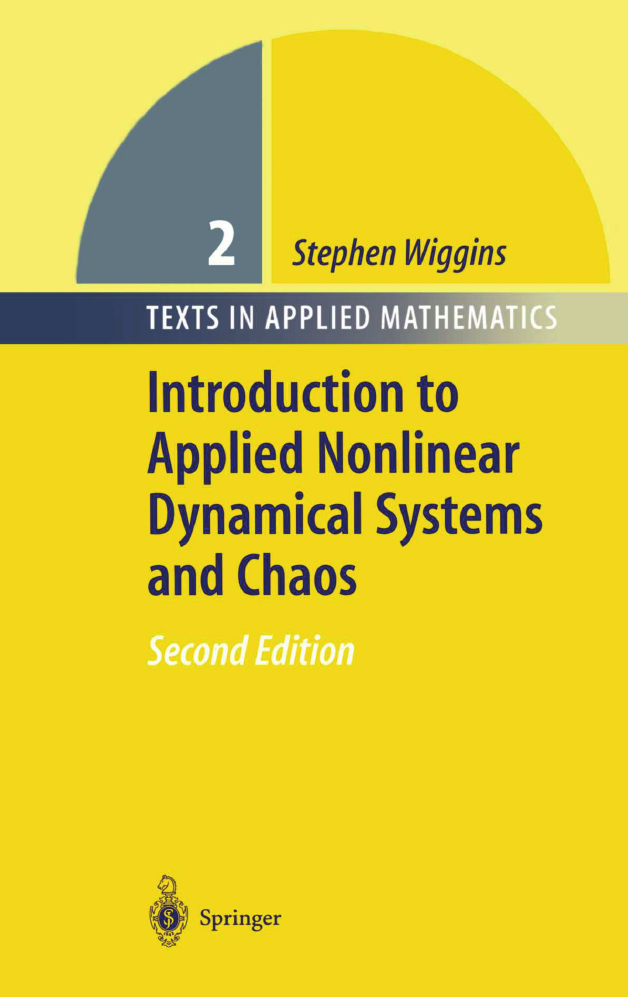


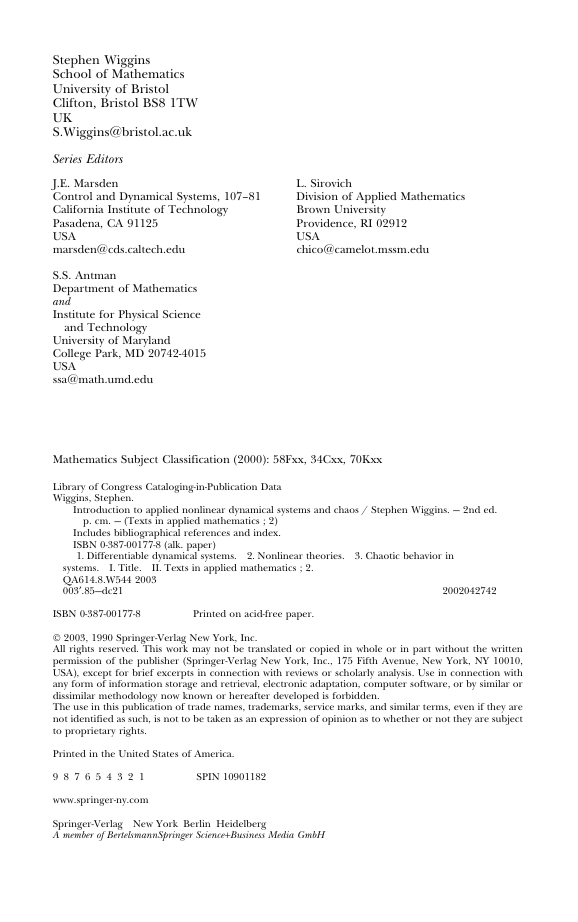

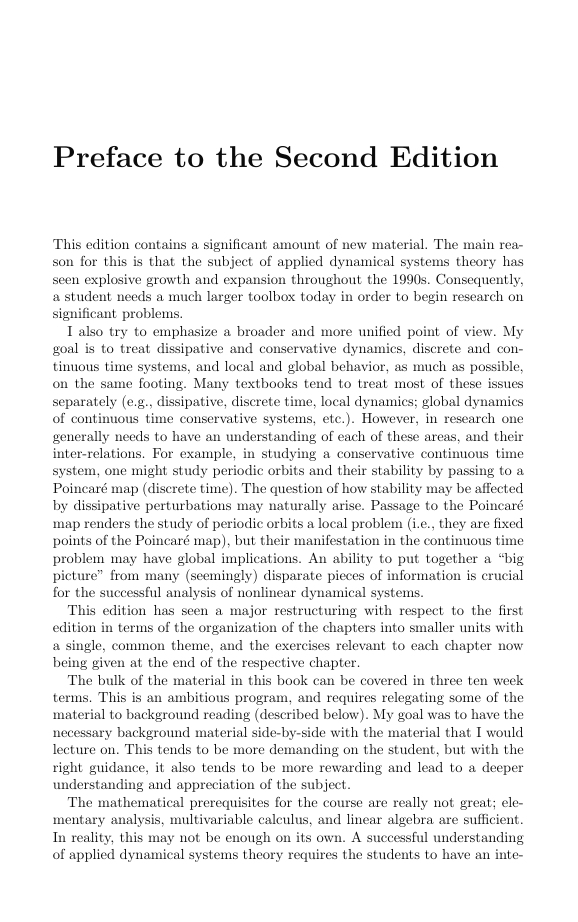
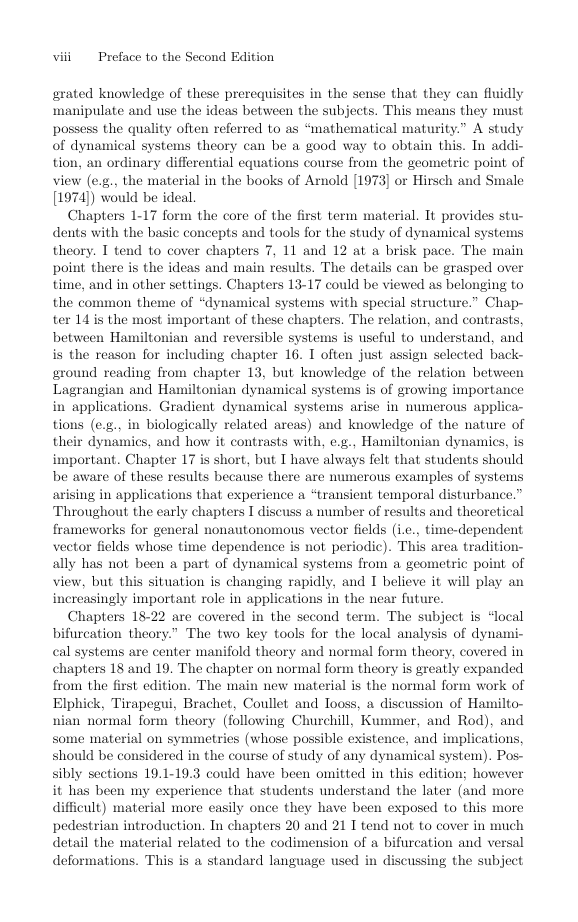
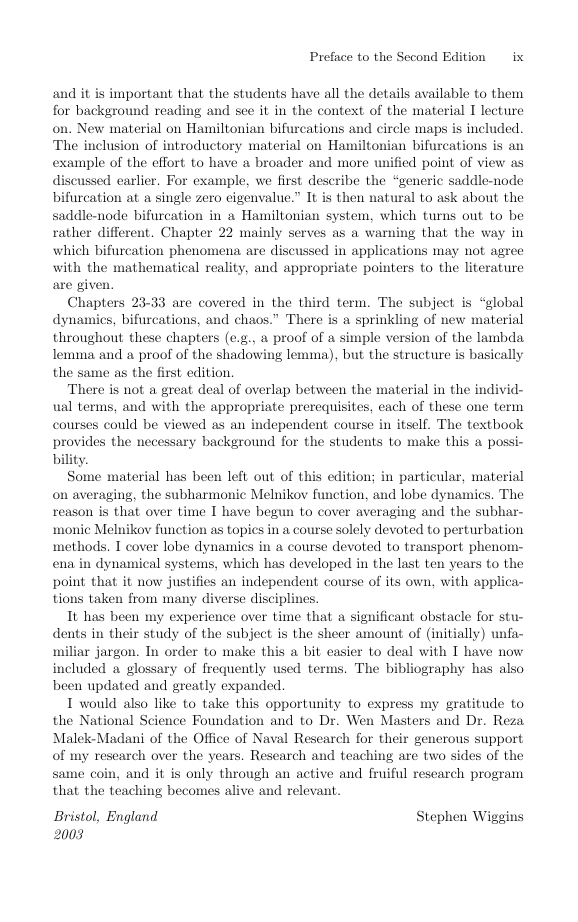








 2023年江西萍乡中考道德与法治真题及答案.doc
2023年江西萍乡中考道德与法治真题及答案.doc 2012年重庆南川中考生物真题及答案.doc
2012年重庆南川中考生物真题及答案.doc 2013年江西师范大学地理学综合及文艺理论基础考研真题.doc
2013年江西师范大学地理学综合及文艺理论基础考研真题.doc 2020年四川甘孜小升初语文真题及答案I卷.doc
2020年四川甘孜小升初语文真题及答案I卷.doc 2020年注册岩土工程师专业基础考试真题及答案.doc
2020年注册岩土工程师专业基础考试真题及答案.doc 2023-2024学年福建省厦门市九年级上学期数学月考试题及答案.doc
2023-2024学年福建省厦门市九年级上学期数学月考试题及答案.doc 2021-2022学年辽宁省沈阳市大东区九年级上学期语文期末试题及答案.doc
2021-2022学年辽宁省沈阳市大东区九年级上学期语文期末试题及答案.doc 2022-2023学年北京东城区初三第一学期物理期末试卷及答案.doc
2022-2023学年北京东城区初三第一学期物理期末试卷及答案.doc 2018上半年江西教师资格初中地理学科知识与教学能力真题及答案.doc
2018上半年江西教师资格初中地理学科知识与教学能力真题及答案.doc 2012年河北国家公务员申论考试真题及答案-省级.doc
2012年河北国家公务员申论考试真题及答案-省级.doc 2020-2021学年江苏省扬州市江都区邵樊片九年级上学期数学第一次质量检测试题及答案.doc
2020-2021学年江苏省扬州市江都区邵樊片九年级上学期数学第一次质量检测试题及答案.doc 2022下半年黑龙江教师资格证中学综合素质真题及答案.doc
2022下半年黑龙江教师资格证中学综合素质真题及答案.doc